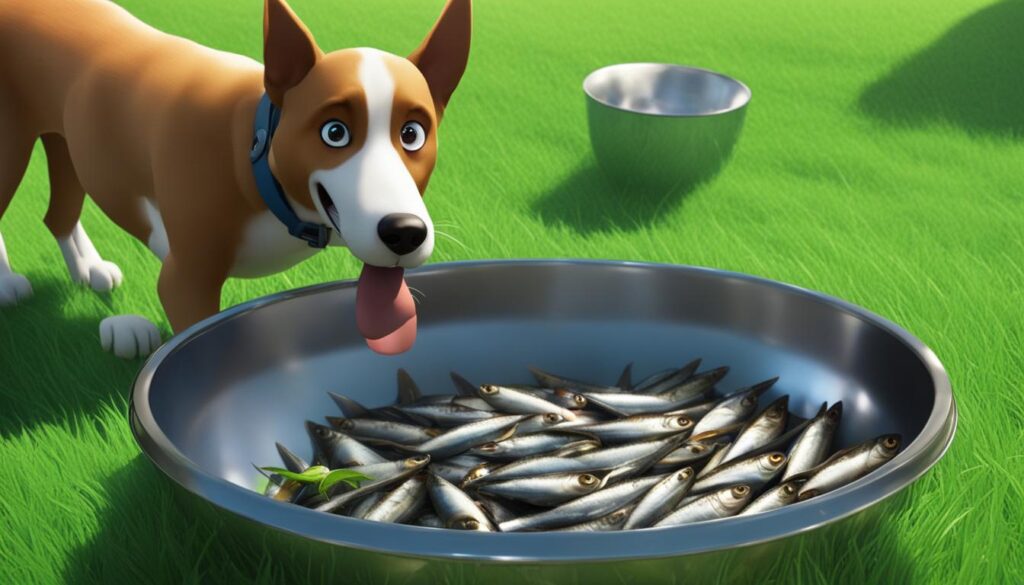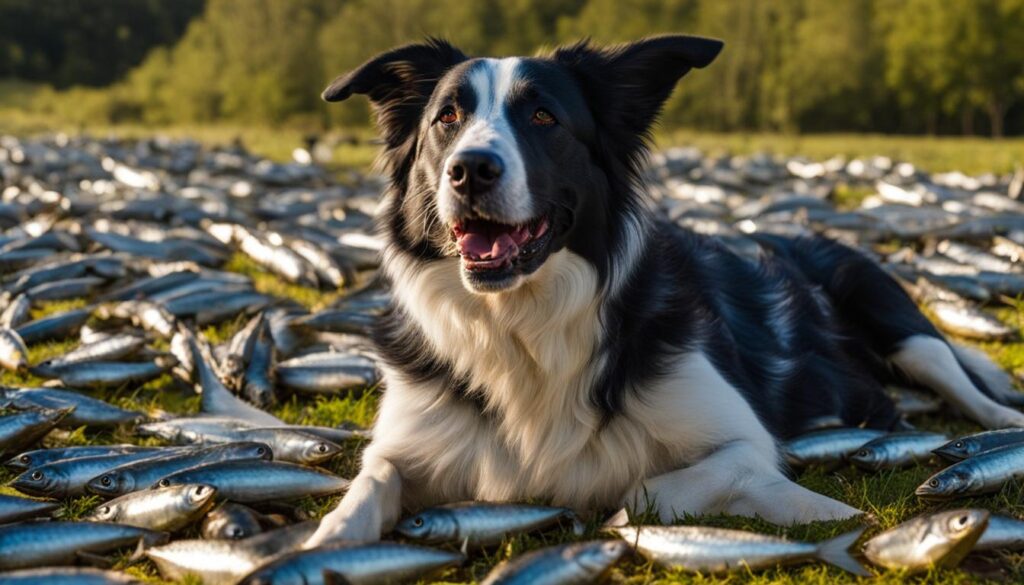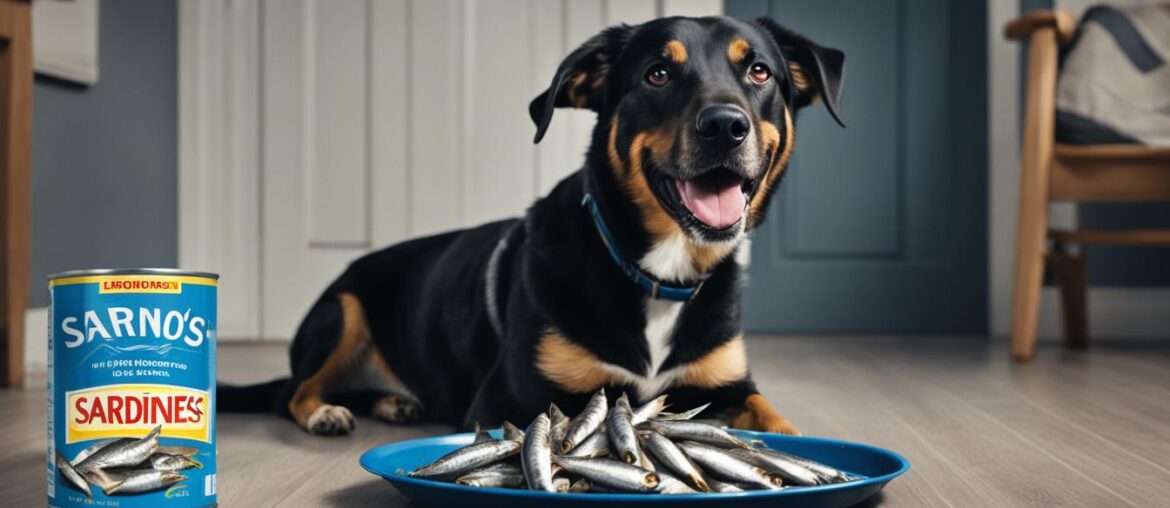As a dog owner, you want to provide your furry friend with a wholesome and nutritious diet. And when it comes to incorporating seafood into their meals, one question that often arises is whether dogs can have sardines. Well, the good news is that sardines can be a safe and beneficial addition to your dog’s diet.
Sardines are small, silver-colored fish that are rich in omega-3 fatty acids, selenium, calcium, phosphorous, Coenzyme Q10, and other essential vitamins and minerals. These nutrients are crucial for promoting a healthy immune system, joints, coat, eyes, and heart in dogs.
Feeding sardines to dogs can be done in different ways. They can be included as part of a raw diet or used as a kibble topper a couple of times per week. The versatility of sardines makes them a convenient and nutritious choice for your furry friend.
However, it’s essential to consider a few factors when feeding sardines to dogs. You need to select high-quality sardines without any harmful additives. It’s also crucial to follow appropriate serving sizes and feeding instructions to ensure your dog’s safety and well-being.
In the following sections, I will provide you with more detailed information about sardines, their nutritional benefits, and how to incorporate them into your dog’s diet effectively.
Key Takeaways:
- Sardines are a nutritious addition to a dog’s diet due to their rich content of omega-3 fatty acids, selenium, calcium, phosphorous, Coenzyme Q10, and other essential vitamins and minerals.
- Feeding sardines to dogs can promote a healthy immune system, joints, coat, eyes, and heart.
- They can be included in a raw diet or used as a kibble topper a couple of times per week.
- Select high-quality sardines without any harmful additives and follow appropriate serving sizes and feeding instructions.
- Consult with your veterinarian to determine if sardines are suitable for your dog’s individual needs.
Sardines 101: Basic Facts About Sardines

Sardines are small, silver-colored fish that belong to the herring family. They are found in oceans all over the world and are a cost-effective option for adding nutrition to a dog’s bowl. Sardines eat phytoplankton and do not consume other animals, making them a lower-toxicity fish source with less mercury and contaminants. Their small size and abundance make them an ideal choice for dogs.
Essential Vitamins and Minerals in Sardines

Sardines are a nutritional powerhouse, packed with essential vitamins and minerals that contribute to a dog’s overall health and well-being. These tiny fish offer a wide range of nutrients that support various bodily functions, promoting vitality and longevity for your furry friend.
One of the key benefits of including sardines in your dog’s diet is their high content of omega-3 fatty acids, which play a crucial role in reducing inflammation, supporting a healthy immune system, and improving joint and bone health. These fatty acids also contribute to a shiny and lustrous coat, giving your dog that healthy and radiant appearance.
In addition, sardines are an abundant source of selenium, a powerful antioxidant that helps protect cells from damage, supports the thyroid gland, and boosts the immune system. They are also rich in calcium and phosphorous, which are essential for maintaining strong bones and teeth.
Sardines contain Coenzyme Q10, a compound that plays a vital role in energy production and supports heart health. With adequate levels of Coenzyme Q10, your dog’s heart can function optimally, promoting cardiovascular well-being.
These small fish are a complete protein source, providing all the essential amino acids necessary for muscle development and repair. They also contain important minerals such as copper, which assists in the production of red blood cells, and choline, which supports brain function and cognitive health.
Furthermore, sardines are packed with various B vitamins, including vitamin B12, which aids in the production of red blood cells and promotes a healthy nervous system. The B vitamins found in sardines are essential for metabolism, energy production, and overall well-being.
| Vitamins | Minerals |
|---|---|
| Omega-3 fatty acids | Selenium |
| B vitamins | Calcium |
| Coenzyme Q10 | Phosphorous |
| Copper | |
| Choline |
By incorporating sardines into your dog’s diet, you can provide them with these essential vitamins and minerals that contribute to their overall health, growth, and vitality. However, it’s important to note that sardines should be fed in moderation, as too much of a good thing can have adverse effects.
Now that we’ve explored the essential vitamins and minerals found in sardines, let’s uncover the many benefits these small fish offer for your canine companion.
7 Main Benefits of Sardines for Dogs

Feeding sardines to dogs provides numerous benefits that contribute to their overall health and well-being. Here are the seven main benefits of incorporating sardines into a dog’s diet:
- Selenium-rich superfood: Sardines are a rich source of selenium, an essential mineral that acts as a powerful antioxidant, supporting a healthy immune system and reducing oxidative stress.
- Supports healthy joints, bones, and muscles: The omega-3 fatty acids found in sardines help reduce inflammation and promote joint health, making them beneficial for dogs with arthritis or joint issues.
- Keeps the coat shiny and healthy: Sardines contain omega-3 fatty acids and protein, essential for maintaining a lustrous and healthy coat. They can help reduce dryness, itchiness, and improve overall skin condition.
- Reduces inflammation: Omega-3 fatty acids in sardines have anti-inflammatory properties, which can alleviate symptoms of inflammation throughout the body, including the skin, joints, and digestive system.
- Boosts heart health and cognitive function: The omega-3 fatty acids in sardines support cardiovascular health by reducing the risk of heart disease and improving brain function, memory, and cognitive abilities in dogs.
- Strengthens retinal health: Sardines are a great source of omega-3 fatty acids, like DHA, which help maintain good retinal health and can improve visual acuity in dogs.
- Linked to tumor growth inhibition: Some studies suggest that the nutrients present in sardines, such as omega-3 fatty acids and selenium, may have anticancer properties and can inhibit the growth of certain tumors.
The nutritional profile of sardines makes them a valuable addition to a dog’s diet, providing a range of essential vitamins, minerals, and nutrients that contribute to their optimal health.
Ways to Purchase Sardines for Your Dog

If you’re considering adding sardines to your dog’s diet, there are several ways to purchase this nutritious fish. Here are some options:
- Raw, Fresh, and Frozen Sardines: Raw sardines are an excellent choice as they contain fewer additives and preserve maximum nutrients. Look for fresh or frozen sardines at your local fish market or supermarket.
- Canned Sardines: Canned sardines can be a convenient option. Ensure you choose sardines packed in water, avoiding those in oil, as excess oil can contribute to weight gain in dogs. It’s important to select sardines without any added spices or flavors.
- Freeze-Dried Sardines: If you’re looking for a convenient travel option or a longer shelf life, freeze-dried sardines are a great choice. They retain their nutritional value and can be easily sprinkled on top of your dog’s meals or used as a tasty treat.
Regardless of the form you choose, it’s crucial to prioritize high-quality sardines for your dog. Look for brands that use responsibly sourced fish and have no harmful additives or preservatives. Reading the labels and researching reputable brands can help ensure you provide the best for your furry friend.
A Comparison of Sardine Purchasing Options
| Form | Pros | Cons |
|---|---|---|
| Raw, Fresh, and Frozen Sardines | – Less sodium | – Requires proper storage and thawing |
| Canned Sardines | – Convenient | – May contain added oil or flavors |
| Freeze-Dried Sardines | – Travel-friendly | – Higher price point |
Feeding Instructions: Giving Sardines to Dogs

Sardines can be a versatile addition to your dog’s diet, whether you use them as a topper, snack, meal, or treat. However, it’s important to remember that sardines should not be the exclusive food for your dog. They should be incorporated into a balanced diet to ensure your dog receives all the necessary nutrients.
The recommended serving size of sardines for dogs is approximately one piece per 20 pounds of body weight. For example, if your dog weighs 40 pounds, you can feed them two sardines. It’s essential to adjust the serving size based on your dog’s specific weight.
When introducing sardines to your dog for the first time, start with a small amount and observe their reaction. Some dogs may have allergies or sensitivities to fish, so it’s crucial to monitor them for any signs of discomfort or adverse reactions. If your dog tolerates sardines well, you can gradually increase the serving size over time.
It’s worth noting that different forms of sardines have specific serving instructions. For fresh or frozen sardines, ensure they are properly thawed before serving to prevent any digestive issues. Canned sardines should be drained and rinsed to reduce the sodium content. Freeze-dried sardines, on the other hand, can be served as is since they retain their nutritional value.
Feeding Recommendations:
- Start with a small amount and observe your dog’s reaction.
- Gradually increase the serving size based on your dog’s weight.
- Thaw fresh or frozen sardines before serving.
- Drain and rinse canned sardines to reduce sodium.
- Feed freeze-dried sardines without any preparation.
| Type of Sardines | Serving Instructions |
|---|---|
| Raw/Fresh Sardines | Thaw in the refrigerator for 24 hours before serving. Can be fed with or without deboning. |
| Canned Sardines | Drain and rinse to reduce sodium content. Serve without any spices or flavors. |
| Freeze-Dried Sardines | Serve as is to retain their nutritional value. |
By following these feeding instructions, you can ensure that your dog receives the benefits of sardines while maintaining a balanced and healthy diet. Remember to consult with your veterinarian regarding any specific dietary requirements or restrictions your dog may have.
How to Serve Sardines to Dogs
When incorporating sardines into your dog’s diet, it’s essential to take the necessary steps to ensure safe and hygienic serving. Whether you opt for whole raw sardines, canned sardines, or freeze-dried sardines, each serving method requires specific considerations.
Serving Whole Raw Sardines
If you choose to serve whole raw sardines, it’s crucial to handle them with care. Start by keeping the sardines frozen until you’re ready to use them. Prior to serving, thaw the sardines in the refrigerator for approximately 24 hours to ensure they’re at the right temperature.
When serving whole raw sardines, you have the option to debone them or serve them as is. Contrary to popular belief, dogs can safely consume whole fish, including the bones. However, if you prefer to remove the bones, be thorough to avoid any potential choking hazards.
Serving Canned Sardines
If you opt for canned sardines, it’s crucial to choose the right type to ensure your dog’s well-being. Look for canned sardines that are packed in water, as oil can add unnecessary fats to your dog’s diet. Before serving, drain and rinse the sardines to reduce sodium content, ensuring they remain a healthy addition to your dog’s meal.
Serving Freeze-Dried Sardines
Freeze-dried sardines offer convenience without compromising nutritional value. These sardines undergo a special drying process that preserves the nutrients while eliminating moisture. When serving freeze-dried sardines, it’s important to verify that the product is whole and raw. This ensures that your dog directly benefits from the complete nutritional profile sardines offer.
Regardless of the serving method, always ensure that the sardines are fresh and of high quality. Proper storage and handling practices are vital to prevent any spoilage or contamination. By serving sardines safely and hygienically, you can provide your dog with a nutritious and delicious treat or addition to their regular meals.
| Serving Method | Recommended Steps |
|---|---|
| Whole Raw Sardines |
|
| Canned Sardines |
|
| Freeze-Dried Sardines |
|
What Dogs Can Eat Sardines?

When it comes to feeding sardines to dogs, it’s important to consider their individual needs and health conditions. Generally, healthy dogs at a normal weight, including puppies, can safely consume sardines as part of their diet. Sardines offer a range of nutritional benefits that support overall canine health.
However, it’s crucial to note that some dogs may have specific dietary restrictions or conditions that require them to avoid or limit sardine consumption. This could include dogs with pancreatitis, allergies, or sensitivities to certain fish species. Consulting with a veterinarian is essential to determine if sardines are suitable for your dog.
Dogs that cannot tolerate excess fat in their diet should also exercise caution when it comes to sardine consumption. While sardines are rich in omega-3 fatty acids and other nutrients, their high-fat content may not be suitable for dogs with certain conditions such as pancreatitis or obesity. Moderation is key in such cases.
Ultimately, the decision to feed sardines to your dog should be made in consultation with a veterinarian who can consider your dog’s specific needs and provide personalized dietary advice.
It’s always better to be safe than sorry when it comes to your dog’s health and nutrition.
Wrapping Up
In conclusion, sardines are a safe and beneficial addition to a dog’s diet. These small, silver-colored fish offer a range of essential vitamins, minerals, and nutrients that support overall health and well-being. Feeding sardines to dogs can provide numerous benefits, including boosting the immune system, supporting joint health, promoting a shiny coat, reducing inflammation, and enhancing heart and cognitive function.
When incorporating sardines into a dog’s diet, it is crucial to choose high-quality sources. Look for sardines that are fresh, frozen, or canned without any harmful additives. Opt for sardines preserved in water rather than oil, and always drain and rinse canned sardines to reduce sodium levels.
Furthermore, it’s important to follow appropriate feeding instructions when serving sardines to dogs. Start with a small amount to observe the dog’s reaction, and gradually increase the serving size over time. Remember that sardines should not be the sole source of nutrition but rather a consistent part of a balanced diet.
In summary, sardines provide a wide range of nutritional benefits for dogs. By incorporating sardines into their diet in a safe and measured way, pet owners can enhance their furry companions’ overall health and well-being.
FAQ
Can dogs have sardines?
Yes, dogs can have sardines. Sardines are a nutritious addition to a dog’s diet and offer various health benefits.
What are the benefits of sardines for dogs?
Feeding sardines to dogs can promote a healthy immune system, joints, coat, eyes, and heart. Sardines are rich in omega-3 fatty acids, selenium, calcium, phosphorous, Coenzyme Q10, and other essential vitamins and minerals.
How often can I feed sardines to my dog?
Sardines can be fed daily as part of a raw diet or a couple of times per week as a kibble topper.
Are sardines a safe fish option for dogs?
Yes, sardines are a safe and cost-effective option for adding nutrition to a dog’s diet. They are small, silver-colored fish that are low in toxicity and contain less mercury and contaminants compared to other fish.
What forms of sardines are suitable for dogs?
Sardines for dogs can be purchased in different forms, such as raw, fresh, frozen, canned, or freeze-dried. It’s important to choose high-quality sardines without any harmful additives.
How should I serve sardines to my dog?
Sardines can be served as a topper, snack, meal, or treat for your dog. The recommended serving size is about one piece per 20 pounds of body weight. Start with a small amount and gradually increase over time. Different forms of sardines have specific serving instructions.
Can all dogs eat sardines?
Generally, healthy dogs at a normal weight, including puppies, can consume sardines. However, dogs with specific dietary restrictions or conditions may need to avoid or limit sardines. It’s essential to consult with a veterinarian to determine if sardines are suitable for your dog’s individual needs.
Where can I purchase sardines for my dog?
Sardines for dogs can be purchased from various sources, including raw or fresh fish markets, grocery stores, pet specialty stores, and online retailers. Choose a reliable source that offers high-quality sardines.
What precautions should I take when serving sardines to my dog?
When serving sardines, ensure they are stored and served safely and hygienically. Raw sardines should be kept frozen until ready to use and thawed in the refrigerator for 24 hours. Canned sardines should be drained and rinsed before serving to reduce sodium. Follow appropriate feeding instructions for different forms of sardines.






